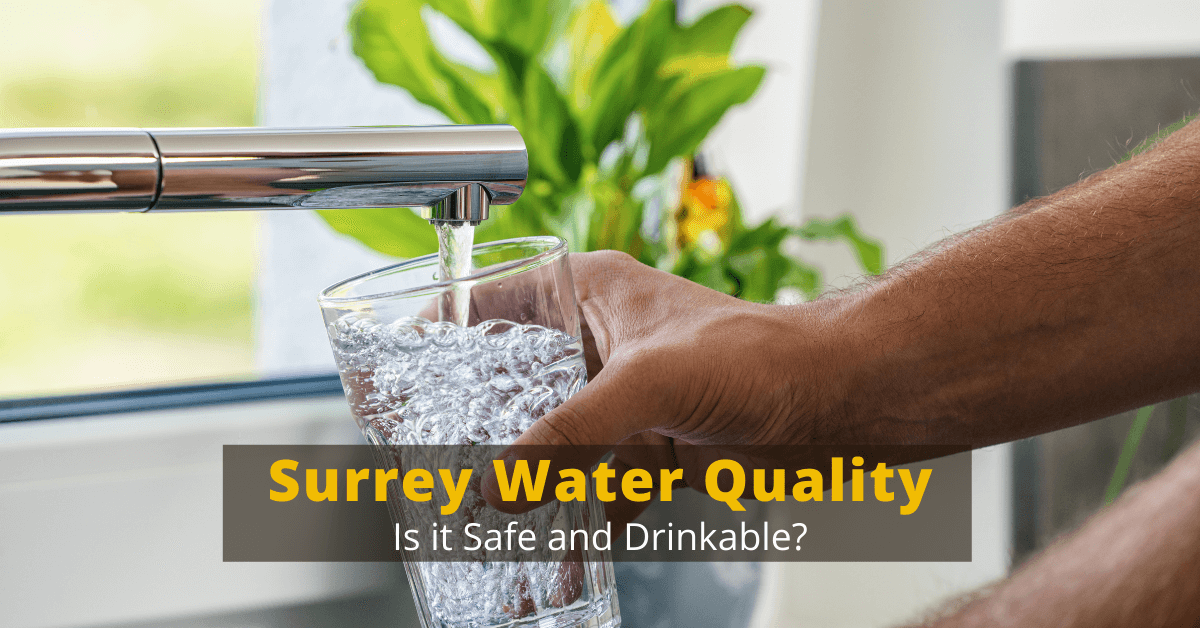People are increasingly worried about the quality of their drinking water, and rightly so. It’s hard to know where your water comes from and whether or not it’s safe to drink. Even if you’re getting your water from a municipal source, you may not know what’s in it.
In this article, we help clear up some of the confusion about Surrey, BC, water. We explain where Surrey’s drinking water comes from, how it is treated, and how you can test its safety yourself. So let’s get started!
So, where’s Surrey’s drinking water come from?

In Surrey, British Columbia, wherein there are 568,322 people as of 2021, Metro Vancouver supplies water. The water system in Surrey is a combined system of reservoirs, treatment plants and transmission mains which draw water from the North Shore Mountains.
The water in Surrey is classified as “soft,” meaning it doesn’t have many minerals that can leave deposits on plumbing or appliances. The City of Surrey monitors water quality regularly, and it meets all provincial and federal guidelines for potability.
Even though Surrey’s water doesn’t need to be filtered, some people still prefer to filter it, especially if they have young children or elderly relatives. In that way, they have another layer of protection against any contaminants in the water.
How do I know if Surrey’s water is safe to drink?
The City of Surrey provides annual water quality reports, which tell you everything you need to know about your water quality. Here is the list:
- 2020 Water System Annual Report
- 2019 Water System Annual Report
- 2018 Water System Annual Report
- 2017 Water System Annual Report
- 2016 Water System Annual Report
- 2015 Water System Annual Report
In the test, they looked for chlorine residue, turbidity (cloudiness), temperature, and bacteria levels for all 51 water stations throughout the city. This is to ensure that the water meets all provincial and federal guidelines.
So to answer the question, “Is Surrey’s water safe to drink?” the answer is yes. However, if you’re still not comfortable drinking tap water, here are the signs of bad quality water that you should be aware of:
4 Signs of Bad Quality Water
1. White flakes or particles in water

White flakes or particles in water are often a sign that your water has high levels of minerals or metals. This could result from corrosion in your home’s plumbing or natural sources like mineral deposits and underground rocks.
While these minerals might not be harmful in small doses, they can cause problems if present at high levels. The particles will make your water look unappetizing, and they can also cause scale build-up on your pipes, fixtures, and appliances.
This will decrease the efficiency of your plumbing and increase your bills. The particles could also clog up your water heater or lead to pipe corrosion in extreme cases.
If you see this sign, you can try filtering your water to remove the particles. Alternatively, you can call your local water authority to find out where your water is from and if it is safe to drink.
2. Cloudy or murky water

Cloudy or murky water is usually a sign of something wrong with the water. This could be due to bacteria, sediment or other organic matter in the water.
All of these substances can cause stomach problems and skin irritations if ingested. Cloudy water can also lead to bad tastes and smells in your tap water.
If you see this sign, you should call your local water authority to find out what is wrong with the water and whether it is safe to drink. You might also need to have your water tested to determine the cause of the cloudiness.
3. Reddish, brown or yellow water

Reddish, brown or yellow water is often a sign of rust in your water pipes. This can be caused by metal corrosion, old fixtures or leaking pipes. If the rust is present at high levels, it can be harmful to your health. It can cause stomach problems, skin irritations and respiratory problems.
If you see this sign, you can contact our surrey location and we will send out a plumber to check out your pipes. If they are corroded, the plumber can recommend a way to fix the problem. You might also need to have your water tested to determine the cause of the discoloration.
4. Foamy or bubbly water

Foamy or bubbly water is often a sign of air in your water pipes. This can be caused by several things, such as a faulty water heater, cracked pipes or incorrect installation of plumbing fixtures.
The presence of air in your water can cause all sorts of problems. It can make your water taste and smell bad, and it can also cause the water to be less hot or less cold. In extreme cases, the air could even cause your plumbing to burst.
If you see this sign, you should contact a professional to have a look at your plumbing. You might also need to have your water tested to determine the cause of the bubbles.
These are the four signs that your water might not be safe to drink. If you see any of these signs, don’t hesitate to call your local water authority for more information.
Conclusion
Surrey’s water is safe to drink and has met all provincial and federal guidelines. However, there are also some factors that you can look out for to ensure the quality of your tap water, such as your water pipes and plumbing system.
If you see any plumbing issues that might affect your drinking water quality in Surrey, we in Your Guy Plumbing are ready to help 24/7. We’ve been providing plumbing solutions for Surrey residents for the past decades.
If you have any questions or want to set up a consultation, please do not hesitate to contact us. At your Guy Plumbing, we’re always here to help!

